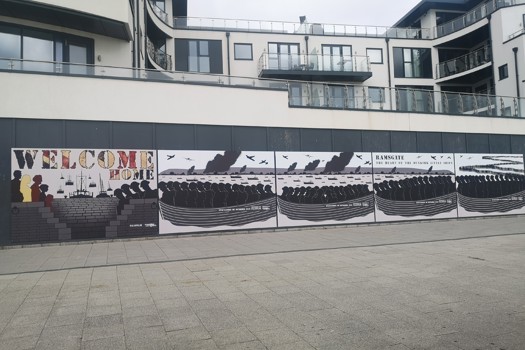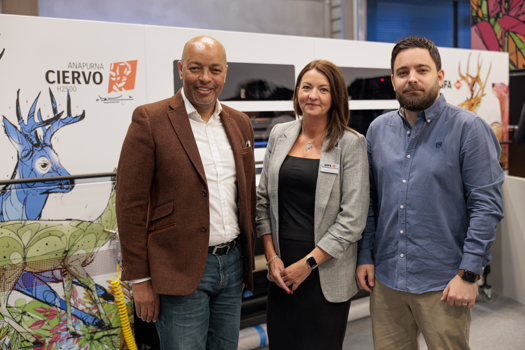It came in the shape of creasing: putting a crease down the fold-line in advance of placing the sheet on the folder pre-stressed the paper and made it more amenable to folding without cracking. Digital finishing manufacturers set out to invent a small, quiet and easy-to-operate creaser that could handle the typically short runs of digital.
The manufacture of digital creasers got underway with the launch of Morgana’s AutoCreaser, an inexpensive hand-fed machine first introduced at Drupa 2000 that could put up to nine creases in any one sheet. Digital printers loved it, and thousands bought it. But the architecture of Morgana’s creasers tends, in the eyes of some, to limit its application. The crease is made by a pair of male-female matrices, one of which rises and falls as the sheet passes under it, and this restricts the machine’s speed. This is the problem Tech-ni-fold’s new creasing machine, the Speedcreasa, aims to solve.
Joint venture
The question of the Speedcreasa’s provenance is a complicated one: devised by one company, made by another and sold by a third. The Speedcreasa was developed as a joint venture between British company Tech-ni-fold and Swiss manufacturer Multigraf. The latter produces the Speedcreasa under licence, and it’s sold in the UK by little-known Sheffield-based digital equipment supplier PrintApply. Multigraf is also responsible for manufacturing the DCM slitter-cutter-creasers that were devised by Tech-ni-fold but are sold by Duplo – described by Tech-ni-fold managing director Graham Harris as “a big brother to the Speedcreasa”.
At the heart of the Speedcreasa are the Tech-ni-fold Tri-Creaser creasing wheels. These ingenious devices, invented by Harris in the early 1990s, are simple wheels incorporating male-female tooling. The sheet travels between an upper (male) and a lower (female) wheel, making the crease (or slit, or perforation, according to the tool). The Tri-Creaser wheels lend themselves to faster work, because the crease, slit or perforation is laid down in the direction of the sheet travel, and adding more creases, slits or perforations is simply a matter of sliding more wheels onto the shafts that hold them. The Speedcreasa can put a maximum of 28 creases into a sheet (the shafts don’t have room for more wheels than that) with a minimum distance of 4mm between each.
There’s an open debate, of course, on whether the Tri-Creaser wheels actually perform creasing or scoring. The manufacturers of rise-and-fall matrix machines contend that it’s scoring, whereas Harris insists that it’s creasing: “With scoring you break the paper fibres – the Tri-Creaser wheels don’t do that,” Harris says. But Andrew Webster of Morgana is adamant that “matrix creasing is the only type of creasing worth the name”.
Cornered market
The Speedcreasa is actively intended to tackle head-on Tech-ni-fold’s biggest competitor, Morgana, which seems to have pretty much cornered the market in low-volume creasing with an array of machines from hand-fed to fully-automatic stream-fed. But the Speedcreasa is more flexible than the Morgana machines: it offers slitting and perforating facilities as well as creasing; it can put more creases or slits or perforations in a sheet; and it can run much faster than the Morganas due to its creasing architecture. However, Tech-ni-fold has chosen to limit the Speedcreasa’s speed by making it a hand-fed machine. It’s for cost reasons, explains Harris: “We wanted to make this machine available to anyone and everyone, and if we’d put an auto-feed on it, that would have whacked the price up.” He points out, too, that the speeds achievable by hand-feeding are “in the same ball-park” as the Morgana automated speeds.
Nobody could accuse Tech-ni-fold of over-complicating the Speedcreasa – it is basically a box with a motor that drives the shaft holding the Tech-ni-fold wheels. The operator puts on a rubber thimble and fans out the sheets into a couple of sidelays. Just 5mm away is a pair of upper and lower rollers on which the Tri-Creaser wheels are mounted. This is driven by the motor, so that when the sheet makes contact with the Tri-Creaser wheels, it’s positively grabbed and driven through the wheels. After the cut, crease and/or perforations have been added, the sheet falls into a delivery tray. The Speedcreasa’s top speed is somewhat dependent on operator dexterity – but Harris says that a practised operator can achieve a top speed of around 3,000 A4 sheets per hour.
Getting the Speedcreasa ready is simple. A test sheet is fed into the lays, which adjust centrally to the edges of the sheet; the sheet is then taken forward to line up with (but not touch) the edges of the Tri-Creaser wheels. The operator judges by eye where the wheels need to be, and positions them by undoing two handles and sliding the wheels left or right. The test sheet is then run through the wheels and any further adjustments are made as necessary. By this means, Harris points out, spoilage is reduced to a single sheet, or perhaps two; makeready is kept to perhaps a minute or two; and operator skill is “really, basically zero”.
Colour-coded
Every Speedcreasa is supplied with three profiles of Tri-Creaser wheels, known as Easyfit, and colour-coded for ease of reference. Orange creases from 85 to 200gsm, blue creases from 200 up to 270gsm, while yellow creases from 250 to 350gsm. The lower tool, mounted onto bearings, offers eight crease widths to accommodate all the upper tool variance. The tools that cut and perforate have been specially designed to avoid the woolly-looking edges that folder-cut documents traditionally have. Harris won’t say how, but says the Multitool (as it’s known) can perforate, edge-trim or double-cut to take a slug out of the sheet’s middle. Finally, there’s an optional spine and hinge creaser that makes four creases – the middle two sit close together to form a book cover spine, the outer two can be used to form a gatefold cover.
All the tools’ knives are made of high-grade steel, and Harris claims they last “at least” five times as long as other rotary cutting tools. To add to this, they’re self-sharpening – the female (lower) tool incorporates a hardened cutting boss with a profile set at a radius, which automatically sharpens the knife as it cuts down onto the boss. The boss also has two faces, both of which can be used before the boss is considered worn out.
Officially launched at Ipex in April, 25 Speedcreasas have been sold in the UK and 60 in the US. The vast majority of customers have been digital printers, says Harris, but he anticipates a wider audience “in time”, coming from sectors including greetings cards, packaging printers, book printers and general commercial offset printers.
SPECIFICATIONS
Max sheet size 480mm wide x any length
Stock thickness 85-350gsm
Max speed around 3,000sph (operator-dependent)
Price £4,495
Contact Tech-ni-Fold 01455 554491 www.tech-ni-fold.com
THE ALTERNATIVES
Bacciottini PitStop AF
Like the Morgana creasers, the PitStop is a rise-and-fall machine with automatic feed. It takes optional perforating tools and there’s a special tool for creasing digitally printed sheets. Makeready is electronic: crease positions are dialled in and there’s room for up to 200 programmes to be saved.
Max sheet size 500x700mm
Stock thickness range 60–600gsm
Max speed 8,000sph
Price £14,950
Contact Encore Machinery 01582 668900 www.encoremachinery.co.uk
Duplo DCM 45
Duplo’s DCM 45 represents a big step up from the Speed-creasa in terms of speed: it multiplies the latter’s speed by a factor of 10, courtesy of an auto-feed. Like the Speedcreasa, it uses the Tri-Creaser wheels. Multiple shafts mean unlimited creases, as close together as required, allowing the DCM to handle stocks up to 500gsm.
Max sheet size 450mm x any length
Stock thickness range 85–500gsm
Max speed 30,000sph
Price £10,500 (includes two sets of creasing tools)
Contact Duplo International 01372 468131 www.duplointernational.co.uk
Morgana DigiCreaser
The matrix-based DigiCreaser is the closest in spec to the Speedcreasa. Hand-fed, it comes as a table-top or a free-standing unit. It can store up to nine programmes for repeat work. An optional stream feed can run the machine faster, but only up to nine creases.
Max sheet size 630x330mm (longer when hand-feeding)
Stock thickness range 85–400gsm
Max speed up to 4,000sph with stream feed
Price £4,630
Contact Morgana Systems 01908 608888 www.morgana.co.uk
Tech-ni-fold Speedcreasa
It was the mid-1990s when digital printers realised that digitally printed sheets had a nasty tendency to crack when folded. The toners that sit on the surface, rather than penetrating the fibres like conventional offset inks, coupled with the superheated fuser rollers that put the final fix on the sheet but also dry it out, were responsible for the problem, and digital printers rose up in their hundreds to demand a solution.






